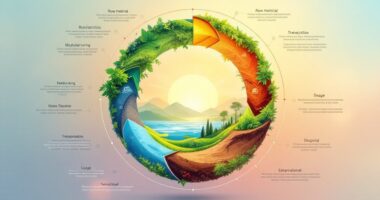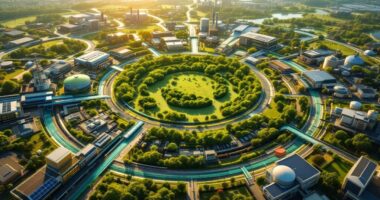Ecosystem services are nature’s essential contributions to human well-being, worth approximately $125 trillion annually—nearly double global GDP. These benefits come in four flavors: provisioning (nature’s pantry providing food and materials), regulating (environmental maintenance crews filtering water and scrubbing carbon), cultural (those mood-boosting scenic views), and supporting (behind-the-scenes soil formation and nutrient cycling). Understanding these services helps communities properly value the natural world’s often invisible—but absolutely indispensable—work on our behalf.

While humans have long reaped the benefits of nature, only recently have we begun to formally recognize these gifts as “ecosystem services.” These essential contributions that ecosystems make to human well-being represent nature’s often-overlooked economic portfolio—a complex web of benefits that sustains our very existence.
The Millennium Ecosystem Assessment cleverly organized these natural perks into four categories, each serving humanity in distinct ways. Provisioning services are nature’s pantry and hardware store—delivering everything from the food on your plate to the timber holding up your roof. Think of them as Earth’s Amazon Prime, but with a much longer track record of reliable delivery.
Regulating services work like nature’s maintenance crew, quietly keeping planetary systems humming along. That forest isn’t just standing around looking pretty—it’s actively scrubbing carbon from the air, while wetlands filter water with efficiency that would make any engineer jealous. Without these services, we’d be scrambling to build mechanical replacements at the bargain price of… trillions of dollars.
Cultural services might seem less tangible, but try putting a price tag on that breathtaking mountain vista or the peaceful birdsong that lowers your blood pressure after a stressful day. These connections to nature feed our souls rather than our stomachs, yet remain essential ingredients in the recipe for human happiness.
Supporting services operate as nature’s backstage crew—they don’t take center stage but nothing happens without them. Soil formation and nutrient cycling lack glamour until you realize they’re the unsung heroes enabling agriculture to exist at all. The protection of biodiversity hotspots is crucial for maintaining these supporting services globally. In recent years, the terminology has evolved to “natures contributions to people” as a more inclusive framework for understanding these benefits.
Collectively, these services pack quite the economic punch—valued at approximately $125 trillion annually. That’s nearly twice the global GDP, quietly working away without sending an invoice. Decision-makers can now utilize Ecosystem Services Tool resources like EnviroAtlas to better incorporate these natural benefits into community planning and environmental management.
Unfortunately, habitat destruction, pollution, climate change, and other human activities are threatening this natural bounty. Like running up a massive tab without checking your bank balance, we’re withdrawing from nature’s account faster than it can regenerate—a sobering reality that calls for immediate attention to our ecological bookkeeping.
Frequently Asked Questions
How Can Individuals Help Protect Ecosystem Services?
Individuals can protect ecosystem services through everyday choices and actions. Reducing consumption by choosing reusable products, properly recycling, and composting helps minimize environmental impact.
Supporting sustainable businesses, using energy-efficient appliances, and adopting eco-friendly transportation further contributes. People can also plant native species, participate in conservation projects, and avoid harmful chemicals.
These collective actions, alongside advocacy for environmental policies, help safeguard the natural systems upon which all life depends.
What Economic Value Do Ecosystem Services Provide Globally?
Ecosystem services provide a staggering economic value globally, estimated between $125-145 trillion annually—significantly exceeding the global GDP of $80-90 trillion.
This represents a dramatic increase from the 1997 estimate of $33 trillion per year.
While markets capture some of this value through provisioning services like food and timber, many regulating and cultural services remain “off the books” despite underpinning all economic activity and human wellbeing worldwide.
Which Ecosystem Services Are Most Threatened by Climate Change?
Climate change most severely threatens provisioning services like food production and freshwater availability due to temperature shifts and altered precipitation patterns.
Regulating services face significant disruption, with carbon sequestration diminishing as ecosystems degrade.
Supporting services such as nutrient cycling and soil formation are increasingly compromised by changing climate conditions.
Cultural services, including tourism and recreation, also face transformation as iconic landscapes shift and biodiversity declines, affecting both economic value and human well-being.
How Are Ecosystem Services Measured or Quantified?
Ecosystem services are measured through multiple complementary approaches.
Biophysical assessments directly quantify ecological parameters and map services based on land cover. Monetary valuation techniques—like revealed preference, stated preference, and benefits transfer methods—assign economic values to these services.
Indicators track service status and trends for decision-making, while integrated assessment frameworks combine biophysical, social, and economic methods to link ecosystem conditions with human wellbeing impacts.
These methods together capture nature’s complex contributions to society.
Can Damaged Ecosystem Services Be Restored Effectively?
Damaged ecosystem services can indeed be restored effectively, though outcomes vary by ecosystem type and degree of degradation.
Research shows restoration can recover biodiversity and reestablish critical services when properly implemented. Success requires both active interventions (like replanting) and passive approaches (removing pressures to allow natural recovery).
While complete restoration to historical conditions isn’t always possible, especially with climate change impacts, well-designed projects can recover significant functionality and deliver substantial environmental and economic benefits.









